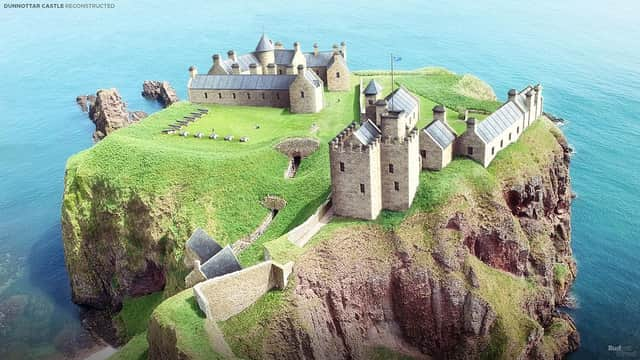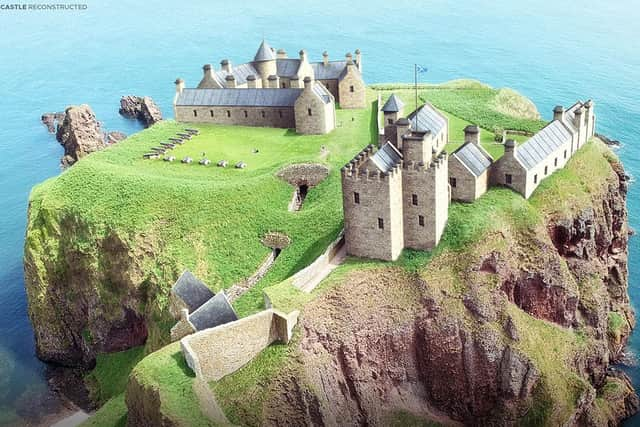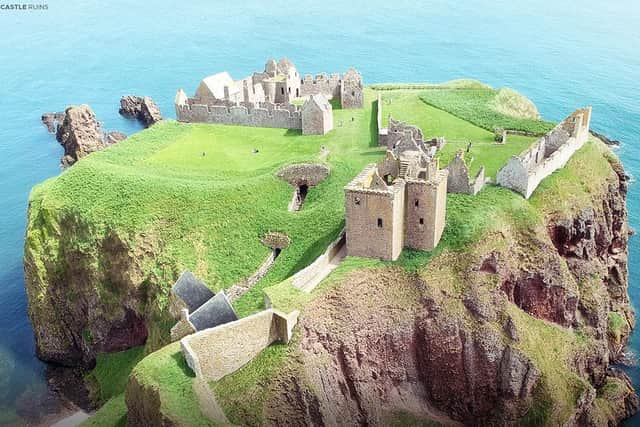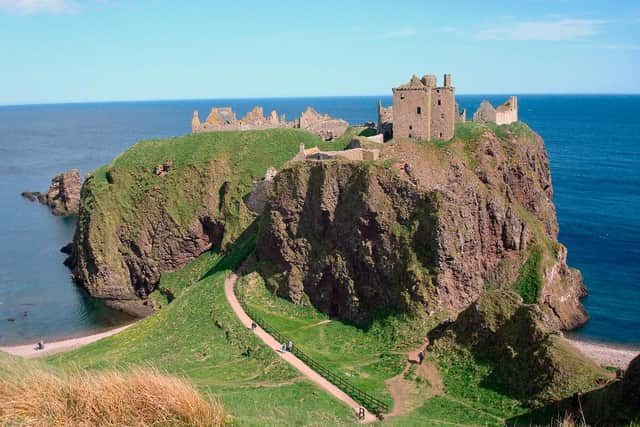Travel back 400 years as Scottish castle 'rebuilt' for armchair travellers


Dunnottar Castle, one of Scotland’s most scenic and well photographed castles, has been ‘rebuilt’ by digital artists and architects to show how the ruin would have looked more than 400 years ago.
The castle, near Stonehaven in Aberdeenshire, was one seven created by a project to reconstruct some of the world’s oldest and most dramatic landmarks for the digital age.
Advertisement
Hide AdAdvertisement
Hide AdTravel firm Budget Direct commissioned the work to offer some “escapism” as the realities of the Covid-19 outbreak bear down.


A statement for the company said: “Over the centuries, many of these magnificent castles have fallen into ruin. Some were abandoned after suffering war damage, while others just fell out of use.
“Budget Direct chose seven of the most unique ruined castles of Europe and, working with a team of designers and
architects, created a series of architectural renders and reconstruction animations that bring them back to their
former glory.


“As efforts to contain the effects of the COVID-19 crisis ramp up, millions of people across the globe are stuck at
home. This project offers a slice of escapism and much-needed armchair travel inspiration.”
The reconstruction of Dunnottar was done using images from the 17th Century.


The castle, which is privately owned by the Pearson publishing family, has played a supporting role in many of Scotland’s key periods of history, from the Picts, to Oliver Cromwell’s invasion to the Jacobites.
Advertisement
Hide AdAdvertisement
Hide AdBut centuries of sieges, invasions and then ultimately abandonment have taken their toll on the coastal fortress, with much of the landmark now a ruin.
Although the buildings of the castle that partly survive today are mostly from the 15th and 16th centuries, the site is believed to have been established in Pictish times.
Indeed, just immediately north of the castle is Dunnicaer, a sea stack once home to a Pictish-era hillfort where some of the oldest symbol stones, dating from the 3rd to 4th Century, were discovered.
The destruction of Dunnottar was first noted in 900AD when Donald II, King of Scots, was according to some accounts killed by Vikings after they invaded the coastal fortress.
By the late 13th Century, it was the site of a Catholic settlement, with a chapel consecrated here in 1276.
This new chapter for Dunnottar was violently interrupted when in 1297 a Scottish force under William Wallace burnt down the church – with a garrison of English soldiers inside.
From the 14th Century onwards Dunnottar Castle was home to the Keiths, one of the most powerful families in Scotland with Sir Robert Keith commanding the Keith Cavalry at the Battle of Bannockburn.
Sir William Keith was the first to to be raised to the peerage in 1458 as the Great Marischal of Scotland.
Advertisement
Hide AdAdvertisement
Hide AdIt was under his leaderhip that the Dunnottar that survives in remants today was built. He built the Tower House, which still looms large on the clifftop site.
The Earl Marischal was the protector of the Crown Jewels and it was at Dunnottar the Regalia of Scotland were hidden from Oliver Cromwell’s army in the 17th Century.
The Crown, sword and sceptre, the oldest Royal Regalia in Britain, were moved to the castle for safekeeping following the coronation of Charles II on January 1 1651.
Oliver Cromwell’s army lay siege and the Castle held out for eight months. Heavy cannons arrived in 1652 and on 24th May that year surrender was made.
A group of local people, including six women, managed to smuggle the jewels out of the castle and take them to Kinneff Church, where they remained until the restoration of the monarchy in 1660.
The castle was later used as a prison to hold 167 Covenanters for three months in 1685 with death and torture the norm in the subteranean hold.
Dunnottar’s role as place of power and associated risks effectively came to an end when the 10th and last Earl Marischal George Keith had his estates – including the castle - seized given by the government his support for the 1715 Jacobite Rising.
For 200 years, the castle was effectively abandoned with the pile slowly slipping away.
Advertisement
Hide AdAdvertisement
Hide AdDunnottar Castle was bought in 1919 by Weetman Pearson, 1st Viscount Cowdray, the great-great grandfather of the current landowner, following years of neglect.
Cowdray was a Yorkshire oil industrialist and Liberal politician who went on to found the Pearson conglomerate, now best known as a publishing house.
For full details of the project visit www.budgetdirect.com.